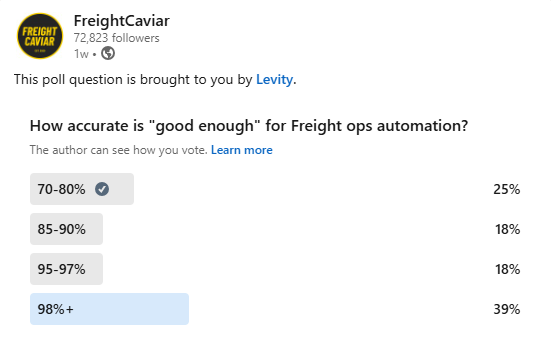🎣 2026 Freight Predictions (Print Preview)
A preview from FreightCaviar Print. December copies are still available.
If your automation tool isn’t hitting 98%+, it’s not saving you money—it’s costing you.

The freight industry has never been more eager to integrate automation into everyday operations. From quoting to order entry, AI is being pitched as the next leap in efficiency. But the truth is more nuanced. Automation that works 80% of the time doesn’t solve your workflow—it becomes another variable to manage.
To explore what freight professionals really expect from automation, we ran a poll on Freight Caviar’s LinkedIn page. The question was simple: How accurate is “good enough” for freight ops automation?

Nearly 40% of respondents said 98% or higher. Another 15% said 95–97%. Only a quarter accepted anything less than 90%. The takeaway? Expectations are high—and they should be.
AI that works most of the time may sound helpful. But in freight, that remaining 20% is where the problems live.
These aren’t harmless errors, they're lost revenue, lost customers, and preventable damage. Levity, for instance, claims a different standard, 98%+ accuracy across quoting and order entry.
Why does that matter?
This isn’t just about trust in the software. It’s about real-world efficiency, where less time is spent fixing AI and more time is spent moving freight.
In a high-volume environment, even small errors compound quickly. Here’s a scenario:
A 2% invoicing error rate on $1.5 million in monthly freight spend amounts to:
When AI systems fall short on accuracy, teams end up doing the work the software was supposed to replace, costing both time and trust. Common fallout from errors includes:
If your team still has to manually Q&A, or babysit, every quote or email the AI produce, what’s really being automated?
The best automation tools are the ones your team forgets about not because they’re irrelevant, but because they just work.
What sets Levity apart, according to users, is its freight-specific design. Instead of bolting generic AI into TMS systems, it was built to interpret rates, documents, and booking flows from the ground up.
Teams using Levity report:
Before assuming your current automation tools are performing well, ask:
If you can’t answer these questions with confidence, it may be time to benchmark. And furthermore, maybe it’s time for a change.
Not every function needs perfection. But quoting, order entry, track-and-trace? These are high-frequency, high-impact processes. Errors here don’t get noticed, they get escalated.
Levity was designed to run these workflows in the background, pulling from real-time data, TMS systems, and email chains without constant oversight.
There’s no value in having automation if you have to babysit everything you are doing. If your AI tool is operating at 80%, you’re still doing 20% of the work and possibly redoing the rest.
That’s why Levity’s model is built around freight workflows with freight-level precision. Because in this industry, “almost right” is just another word for wrong.
Interested in what 98%+ looks like in action? Learn more at Levity.ai.
Join over 14K+ subscribers to get the latest freight news and entertainment directly in your inbox for free. Subscribe & be sure to check your inbox to confirm (and your spam folder just in case).